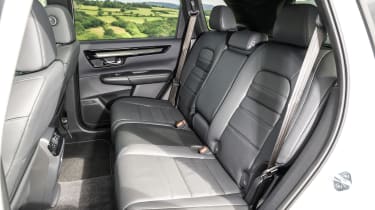Honda CR-V - Practicality, comfort and boot space
The Honda CR-V should offer all the space you’d need. It’s odd that e:PHEV has the largest boot, though


Those in the front of the Honda CR-V will have plenty of space to stretch out, plus it’s taller than most of its rivals (except for the Hyundai Santa Fe and Kia Sorento), so you get the elevated driving position expected of an SUV. It contributes to the CR-V’s excellent visibility, bolstered further by standard front and rear parking sensors and a reversing camera. Step up to Advance, and you get a 360-degree camera system, while Advance Tech has side parking sensors to help cover all angles and sides.
All versions of CR-V have electric front seats, so it’ll be easy to find a good driving position. Leg- and shoulder room are plentiful, and the standard panoramic glass roof doesn’t significantly impact head room.
You get a large central armrest with a sizable storage space underneath. A pair of cup holders is ahead of that, and ahead of the gear selector is the wireless phone charging pad. The door bins and glove box aren’t the largest around. Still, at least the latter isn’t as disappointingly small as what you’ll find in a Peugeot 5008.
Size
The latest generation is also the biggest CR-V ever. An extra 106mm in total length frees up 38mm in wheelbase length, meaning there’s an extra 15mm of rear legroom compared with the previous version.
Used - available now
At 4,706mm in length, the CR-V is longer than a 5008, and a little shorter than a Santa Fe and Sorento. The CR-V is wider than both, so it seems a shame that Honda didn’t manage to give this SUV three individual rear seats like the 5008 despite the extra space.
Leg room, head room & passenger space
Rear knee room for taller passengers is impressive, easily on a par with rivals like the Toyota RAV4. The rear seatbacks can recline through eight positions to increase passenger comfort on longer trips, while the flat floor and wide centre seat make it comfortable for three. It’s a shame you can’t get a more flexible sliding rear bench, as per the Audi Q5 and Renault Austral, to vary boot space or leg room, though.
ISOFIX points are provided for the outer positions of the rear seats. Helpfully, the rear doors open out up to 90 degrees, giving parents or grandparents who need to put children in child seats much greater access to the back seats. It’s a trick Nissan has also added to models like the seven-seat X-Trail, so we welcome its inclusion on the CR-V.
Boot
Unlike every other car that comes as a plug-in hybrid, the CR-V PHEV has the largest boot in the CR-V range. It’s a healthy 617 litres (635 litres including the storage space below the floor) compared to the hybrid’s 596 litres, and it usefully still has space for the charging cables.
This is because the fuel tank that lives under the rear seats has been shrunk in the e:PHEV version, with the battery utilising the leftover space. The e:HEV hybrid has a bigger tank, so the battery pack in this model has to go under the boot floor, taking up valuable space.
The rear seats fold in a 60/40 split, which is average for the class, whereas rivals like the Q5 or BMW X3 have a far more versatile 40/20/40 layout. Also, there’s a step in the boot floor with the seats down in the e:PHEV version, making it more awkward to slide longer items of flat-pack furniture into the boot.
Towing
Anyone interested in towing must fork out for the priciest Advance Tech PHEV model because that can pull a 1,500kg braked trailer or caravan. The regular e:HEV hybrid can only manage a disappointing 750kg, less than the Hyundai Santa Fe or Toyota RAV4, which can tow up to 1650kg.
As we mentioned earlier, the PHEV model is only front-wheel drive, and this could make it difficult for anyone trying to tow anything across slippery terrain, such as a grass field after it’s been rained on.












